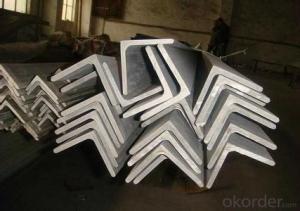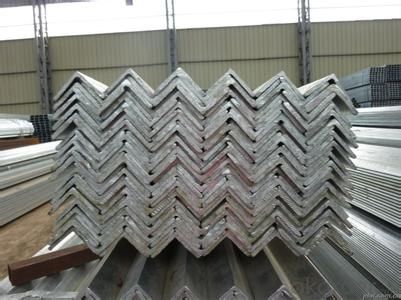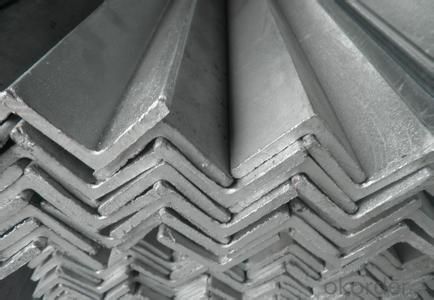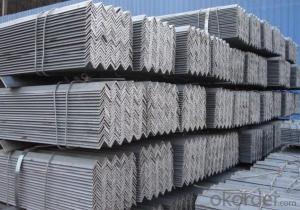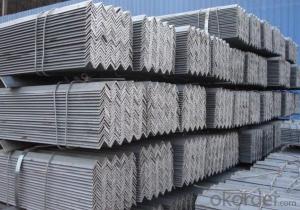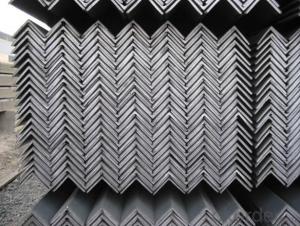High quality angle steel GB Q235B 20-250MM
- Loading Port:
- Tianjin
- Payment Terms:
- TT OR LC
- Min Order Qty:
- 25 m.t.
- Supply Capability:
- 10000 m.t./month
OKorder Service Pledge
OKorder Financial Service
You Might Also Like
Angle Steel Details:
| Minimum Order Quantity: | 25mtons | Unit: | m.t. | Loading Port: | China Main Port |
| Supply Ability: | 80000-100000MTS/YEAR | Payment Terms: | TT or LC |
Product Description:
Specifications of Angle Steel
1. Invoicing on theoretical weight or actual weight as customer request
2. Length: 6m, 9m, 12m as following table
3. Sizes
Sizes: 25mm-250mm | ||
a*t | ||
25*2.5-4.0 | 70*6.0-9.0 | 130*9.0-15 |
30*2.5-6.6 | 75*6.0-9.0 | 140*10-14 |
36*3.0-5.0 | 80*5.0-10 | 150*10-20 |
38*2.3-6.0 | 90*7.0-10 | 160*10-16 |
40*3.0-5.0 | 100*6.0-12 | 175*12-15 |
45*4.0-6.0 | 110*8.0-10 | 180*12-18 |
50*4.0-6.0 | 120*6.0-15 | 200*14-25 |
60*4.0-8.0 | 125*8.0-14 | 250*25 |
5. Payment terms:
1).100% irrevocable L/C at sight.
2).30% T/T prepaid and the balance against the copy of B/L.
3).30% T/T prepaid and the balance against L/C
6.Material details:
Alloy No | Grade | Element (%) | |||||
C | Mn | S | P | Si | |||
|
|
|
|
|
|
| |
Q235 | B | 0.12—0.20 | 0.3—0.7 | ≤0.045 | ≤0.045 | ≤0.3 | |
|
|
|
|
|
|
| |
Alloy No | Grade | Yielding strength point( Mpa) | |||||
Thickness (mm) | |||||||
≤16 | >16--40 | >40--60 | >60--100 | ||||
≥ | |||||||
|
|
|
|
|
| ||
Q235 | B | 235 | 225 | 215 | 205 | ||
Alloy No | Grade | Tensile strength (Mpa) | Elongation after fracture (%) | ||||
Thickness (mm) | |||||||
| ≤16 | >16--40 | >40--60 | >60--100 | |||
≥ | |||||||
|
|
|
|
|
|
| |
Q235 | B | 375--500 | 26 | 25 | 24 | 23 | |
Usage & Applications of Angle Steel
According to the needs of different structures, Angle can compose to different force support component, and also can be the connections between components. It is widely used in various building structures and engineering structures such as roof beams, bridges, transmission towers, hoisting machinery and transport machinery, ships, industrial furnaces, reaction tower, container frame and warehouse etc.
Packaging & Delivery of Angle Steel
1. Packing: it is nude packed in bundles by steel wire rod
2. Bundle weight: not more than 3.5MT for bulk vessel; less than 3 MT for container load
3. Marks:
Color marking: There will be color marking on both end of the bundle for the cargo delivered by bulk vessel. That makes it easily to distinguish at the destination port.
Tag mark: there will be tag mark tied up on the bundles. The information usually including supplier logo and name, product name, made in China, shipping marks and other information request by the customer.
If loading by container the marking is not needed, but we will prepare it as customer request.
Production flow of Angle Steel
Material prepare (billet) —heat up—rough rolling—precision rolling—cooling—packing—storage and transportation
vv
- Q: Can steel angles be used in cold climates?
- Yes, steel angles can be used in cold climates. Steel is known for its durability and strength, making it suitable for various weather conditions, including cold climates. However, it is important to consider the specific requirements and properties of the steel angles being used to ensure they are appropriate for the specific cold climate conditions, such as low temperatures, snow, and ice. Proper insulation and protective coatings may also be necessary to enhance their performance and longevity in cold climates.
- Q: What is the maximum allowable tensile stress for a steel angle?
- The maximum tensile stress that a steel angle can withstand depends on several factors, including the grade of steel, the manufacturing process, and the intended use. Steel angles are commonly used in construction and structural applications, and their maximum tensile stress is typically determined by industry standards and design codes. For instance, in the United States, the American Institute of Steel Construction (AISC) provides design specifications for structural steel angles. According to AISC, the maximum tensile stress for a steel angle is typically based on its yield strength. Yield strength refers to the stress at which a material permanently deforms. It is usually specified in pounds per square inch (psi) or megapascals (MPa). Steel angles are generally designed to operate within a certain percentage of their yield strength to ensure safety and structural integrity. In general, the maximum tensile stress for a steel angle is often restricted to a percentage of its yield strength, typically ranging from 50% to 70%. This means that the maximum stress that can be applied to a steel angle is a fraction of its yield strength. To determine the specific maximum tensile stress for a particular steel angle in a specific application, it is important to consult the appropriate design standards and codes, such as those provided by AISC or other relevant organizations. These standards take into account factors like load conditions, safety factors, and environmental conditions to guarantee the reliability and structural integrity of the steel angle.
- Q: How do you determine the strength of a steel angle?
- The strength of a steel angle depends on various factors, such as its material composition, size, and shape. In terms of material composition, the type of steel used greatly affects its strength. Steel angles are commonly made from alloys like carbon steel or stainless steel, each with their own unique strength properties. The grade or type of steel employed directly impacts the angle's strength, with higher-grade steels generally exhibiting greater strength. The size of the steel angle is also a significant factor in determining its strength. The angle's dimensions, including its length, width, and thickness, directly influence its load-bearing capacity. Generally, larger and thicker steel angles are capable of withstanding higher loads and forces. Furthermore, the shape of the steel angle plays a role in its strength. Typically, steel angles are available in L-shapes, where the legs are perpendicular to one another. The length and angle of the legs can impact the angle's strength. For instance, longer legs or a steeper leg angle can increase the strength and load-bearing capacity of the steel angle. To accurately determine the strength of a steel angle, engineers typically perform calculations and analysis. These calculations involve considering the material properties, dimensions, and loading conditions to ascertain the maximum load or stress the angle can withstand without failure. Additionally, industry standards and codes, such as those established by organizations like ASTM or AISC, provide guidelines and specifications for assessing the strength of steel angles.
- Q: What are the advantages of using steel angles over other materials?
- There are several advantages of using steel angles over other materials. Firstly, steel angles are known for their superior strength and durability. Steel is a highly robust material that can withstand heavy loads and extreme weather conditions. This makes steel angles ideal for structural applications where strength and stability are crucial, such as in building construction and bridge supports. Secondly, steel angles offer excellent versatility in design and fabrication. They can be easily cut, welded, and formed into various shapes and sizes, allowing for customized solutions that meet specific project requirements. This adaptability makes steel angles suitable for a wide range of applications, including frameworks, support brackets, and reinforcements. Furthermore, steel angles have a high resistance to corrosion. Steel is inherently resistant to rusting and can be further protected through various coatings or galvanization processes. This corrosion resistance ensures the longevity and low maintenance of steel angles, making them a cost-effective choice in the long run. Additionally, steel angles offer a high degree of fire resistance. Steel does not burn or contribute to the spread of fire, which is particularly important in applications where fire safety is a concern, such as in building structures or industrial facilities. Lastly, steel angles are readily available and cost-effective. Steel is one of the most widely used materials in the construction industry and is readily available in various sizes and grades. The abundance of steel makes it a cost-effective option, especially when compared to alternative materials that may have limited availability or higher manufacturing costs. In summary, the advantages of using steel angles include their strength, versatility, corrosion resistance, fire resistance, and cost-effectiveness. These qualities make steel angles a preferred choice for many construction and structural applications.
- Q: What are the different test methods used to evaluate steel angles?
- Some of the different test methods used to evaluate steel angles include tensile testing, bend testing, impact testing, hardness testing, and dimensional inspection.
- Q: Can steel angles be used in the construction of hospitals?
- Yes, steel angles can be used in the construction of hospitals. Steel angles are versatile and commonly used in various construction projects, including hospitals. They provide structural support, reinforcement, and are often used for framing, bracing, and connecting different components of a building. Steel angles offer strength, durability, and fire resistance, making them suitable for hospital construction where safety and stability are crucial.
- Q: Can steel angles be galvanized or coated for corrosion resistance?
- Yes, steel angles can be galvanized or coated for corrosion resistance. Galvanizing is a common method used to protect steel from corrosion by applying a layer of zinc to the surface. This process creates a barrier between the steel and the external environment, preventing the formation of rust. Coating steel angles with corrosion-resistant materials such as epoxy or powder coatings is another option to enhance their resistance to corrosion. These coatings act as a protective layer, preventing moisture and other corrosive elements from reaching the steel surface. By applying galvanization or coatings, steel angles can significantly increase their lifespan and maintain their structural integrity in corrosive environments.
- Q: How do steel angles perform under high temperatures?
- Due to their high melting point and exceptional heat resistance, steel angles exhibit excellent performance in high-temperature conditions. Steel, a widely utilized material in construction and engineering, is renowned for its robustness and durability. Steel angles, when subjected to elevated temperatures, maintain their structural integrity and do not easily deform or weaken. This is primarily due to steel's elevated melting point, typically ranging from 1370 to 1530 degrees Celsius (2500 to 2800 degrees Fahrenheit), enabling it to endure extreme heat without significant harm. Moreover, steel possesses outstanding heat resistance, enabling efficient heat dissipation and maintaining stability when confronted with high thermal loads. Consequently, steel angles are suitable for applications involving elevated temperatures, such as industrial furnaces, power plants, or high-temperature environments. However, it is crucial to acknowledge that the specific performance of steel angles under high temperatures can vary depending on the steel's grade and composition, as well as the intensity and duration of heat exposure.
- Q: What are the common methods of surface cleaning for steel angles?
- Steel angles can be cleaned using various methods to remove dirt, rust, paint, and other contaminants, ensuring a smooth and clean surface. Mechanical cleaning is a widely used method that involves scrubbing the surface with abrasive materials like sandpaper, wire brushes, or abrasive pads. This is effective for spot cleaning or smaller areas. Chemical cleaning, on the other hand, utilizes chemicals or solvents to dissolve or loosen contaminants. A cleaning solution is applied directly to the steel angles and then scrubbed with a brush or cloth. This method is useful for larger areas or stubborn stains and paints. Power washing, also known as pressure washing, is another popular method for cleaning steel angles. It involves using a high-pressure water jet to remove dirt, dust, and loose particles. Power washing is efficient for large areas or for eliminating loose rust or paint. Abrasive blasting is a highly effective method that utilizes compressed air to propel abrasive materials like sand or steel grit onto the surface of the steel angles. This method is particularly useful for removing heavy rust, paint, or scale, leaving a clean and smooth finish. It is important to consider the condition of the steel angles and the desired level of cleanliness when choosing a cleaning method. Some methods may be more suitable for specific applications and may require specialized equipment. Furthermore, it is crucial to follow proper safety precautions, including wearing protective gear and ensuring adequate ventilation, when using any cleaning method.
- Q: Can steel angles be used in shelving systems?
- Yes, steel angles can be used in shelving systems. Steel angles provide excellent structural support and stability, making them a popular choice for shelving units. They can be easily attached to walls or used as vertical supports, allowing for the customization of shelving layouts. Additionally, steel angles are durable and capable of holding heavy loads, making them suitable for various storage needs.
Send your message to us
High quality angle steel GB Q235B 20-250MM
- Loading Port:
- Tianjin
- Payment Terms:
- TT OR LC
- Min Order Qty:
- 25 m.t.
- Supply Capability:
- 10000 m.t./month
OKorder Service Pledge
OKorder Financial Service
Similar products
Hot products
Hot Searches
Related keywords
